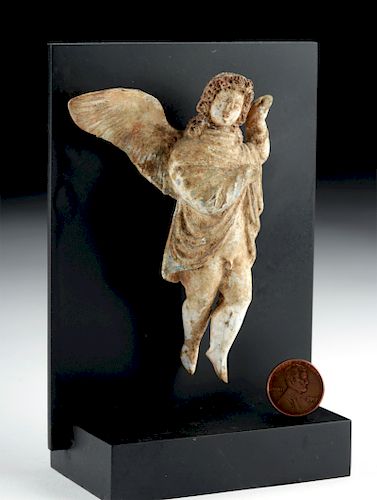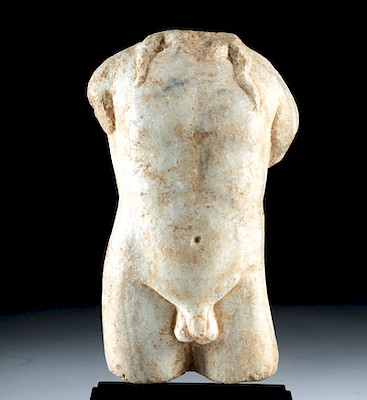Canosan Terracotta Winged Cherub / Erote
Lot 27
About Seller
Artemis Gallery
686 S Taylor Ave, Ste 106
Louisville, CO 80027
United States
Selling antiquities, ancient and ethnographic art online since 1993, Artemis Gallery specializes in Classical Antiquities (Egyptian, Greek, Roman, Near Eastern), Asian, Pre-Columbian, African / Tribal / Oceanographic art. Our extensive inventory includes pottery, stone, metal, wood, glass and textil...Read more
Estimate:
$1,000 - $1,500
Absentee vs Live bid
Two ways to bid:
- Leave a max absentee bid and the platform will bid on your behalf up to your maximum bid during the live auction.
- Bid live during the auction and your bids will be submitted real-time to the auctioneer.
Bid Increments
| Price | Bid Increment |
|---|---|
| $0 | $25 |
| $300 | $50 |
| $1,000 | $100 |
| $2,000 | $250 |
| $5,000 | $500 |
| $10,000 | $1,000 |
| $20,000 | $2,500 |
| $50,000 | $5,000 |
| $100,000 | $10,000 |
| $200,000 | $20,000 |
About Auction
By Artemis Gallery
Dec 5, 2018
Set Reminder
2018-12-05 10:00:00
2018-12-05 10:00:00
America/New_York
Bidsquare
Bidsquare : DAY 1 | Classical Antiquities & Asian Art
https://www.bidsquare.com/auctions/artemis-gallery/day-1-classical-antiquities-asian-art-3698
Day 1 of an important 2-day auction featuring ancient and ethnographic art from around the world. Egyptian, Greek, Roman, Viking, Near Eastern plus Asian Art from China, Japan, Thailand, Vietnam, Burma, India, more. Artemis Gallery info@artemisgallery.com
Day 1 of an important 2-day auction featuring ancient and ethnographic art from around the world. Egyptian, Greek, Roman, Viking, Near Eastern plus Asian Art from China, Japan, Thailand, Vietnam, Burma, India, more. Artemis Gallery info@artemisgallery.com
- Lot Description
Magna Graecia, Apulia, Canosan Hellenistic Period, ca. 3rd to 2nd century BCE. An elegant votive figure of a winged cherub - perhaps Eros or an Erote - wearing a voluminous cloak, the fabric of which drapes over his shoulders and upper body, but still reveals his lower abdominal region, genitals, and fluttering legs. The figure is presented in a dynamic, perhaps flying or alighting pose, with the left leg before the right, the right arm crossed over his chest, the left arm raised, and his head delightfully leaning towards the left. What's more, his visage is skillfully delineated with delicate features framed by a curly coiffure that falls to and beyond his shoulders - and his wing is nicely detailed with plumage. Further contributing to its allure is the rich red and white pigment remaining on the piece. Size: 4" H (10.2 cm)
Canosa, or Canosion as it was known then, was a major center of the ceramics and pottery trade when it was a Greek polis. It's artists produced truly unique pottery, completely different in decoration style from earlier and neighboring traditions. The clay is buff, with the decoration applied directly to it without the use of slip. In this example, the surface is liberally adorned with red and white pigments.
Provenance: private Southern California, USA collection, acquired in the 1970s to mid-1980s
All items legal to buy/sell under U.S. Statute covering cultural patrimony Code 2600, CHAPTER 14, and are guaranteed to be as described or your money back.
A Certificate of Authenticity will accompany all winning bids.
We ship worldwide and handle all shipping in-house for your convenience.
#140686Missing one wing. Normal surface wear with some pigment loss and abraded areas commensurate with age. Details remain strong, and much original pigment remains.Condition
- Shipping Info
-
All shipping is handled in-house for your convenience. Your invoice from Artemis Gallery will include shipping calculation instructions. If in doubt, please inquire BEFORE bidding for estimated shipping costs for individual items.
-
- Buyer's Premium



 EUR
EUR CAD
CAD AUD
AUD GBP
GBP MXN
MXN HKD
HKD CNY
CNY MYR
MYR SEK
SEK SGD
SGD CHF
CHF THB
THB













